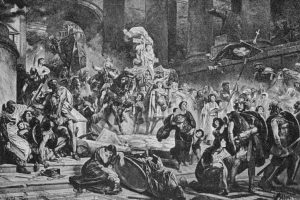A time traveler to Europe’s Early Middle Ages might be startled by what they found if they landed there in mid-December. No jolly good cheer, no feasts, no chestnuts roasting over crackling fires—only silence and prayer. Long before Advent calendars and shopping days, Christians observed the season with a far different rhythm, one focused on prayer, repentance, and fasting.
A solemn season
From the fourth through the eighth centuries, Advent began not four Sundays before Christmas but on November 11, St. Martin’s Day. The six-week stretch from mid-November through Christmas Day was sometimes known as St. Martin’s Lent. Like Lent, medieval Advent included dietary restrictions, limited festivity, and a call to spiritual renewal. Overeating at holiday parties and get-togethers wasn’t a problem in those days; no meat, dairy, alcohol, or excess of any kind was allowed.
Medieval Advents were not much like today’s liturgical celebrations, which overflow with candlelight, pageants, and joyful carols. Long-ago Advents stand in even sharper contrast to our mainstream society’s flurry of shopping, baking, and partying. Back then, Advent was not a time for fuzzy feelings or festive gatherings, and Christians did not gather around cozy creches or join in angelic song. When Christmas Day arrived, they celebrated (for 12 full days!), but until then, Advent was a bleak, cold time, the midnight of the Christian year.
The church did not spend much time looking back through the centuries to the miracle of Jesus’ birth. Instead, Christians focused on the present moment while acknowledging the future consequences of their actions and attitudes. The church called its members to face life’s ugliest and most painful realities: human cruelty, selfishness, apathy, laziness, and institutional injustice. Advent was an opportunity for a long, careful look at the ways we fail one another, the Earth on which we live, and the God we seek to serve.
In other words, the season was not so much a celebration as a wake-up call.
Preparing for judgment
Today, Advent is a time to rush around with shopping lists clutched in hand while we grow ever more stressed by all the things we “need” to get done. In our quieter moments, we may remember we’re also preparing for the Christ child’s arrival. Very few of us, though, spend much time thinking of Judgment Day, death, or hell.
But those medieval Christians did. Even the candles in the Advent wreath had different meanings back then. While today we say the candles represent hope, peace, joy, and love, medieval folk said the candles stood for the four “Last Things”: death, judgment, hell, and heaven. Instead of singing joyful carols like “Away in a Manger” and “Silent Night,” churchgoers would have sung Advent hymns more like this one, titled “Day of Wrath” (written in the 13th century):
Dreadful day, a world in mourning . . .
I kneel low, my heart laid bare—
see my sorrow, ash and shadow.
Help me now, in this final hour.
Not a very cheery song. Hard to imagine children’s eyes shining with excitement when they heard these words—or that adults’ vision misted over with sentimental tears.
What this hymn did do, though, was encourage Christians to see past the pressures and distractions of daily life. It called them to face the desperation of their own broken hearts, as well as the broken world around them. It offered them an opportunity to remember that human selfishness has a cost. It called them to the humility and profound life changes necessary for reconnection with one another, with the Earth, and with God.
While I’m not comfortable with the medieval church’s belief in the fires of a literal hell, I do believe God allows us to create our own internal and external hells. These are emotional and societal dead ends where hope languishes and fear and hatred thrive. I wonder how our world might be changed for the better if we recognized and feared these hells of our own making the way medieval folk feared the consequences of their failures.
While we see anxiety and fear as negative emotions, the medieval church perceived them as potentially healthy, capable of nudging us back into alignment with the divine vision of wholeness and love. As St. Maximus the Confessor wrote in the seventh century: “If you have faith in the Lord . . . fear will lead you to control the passions, [the selfishness that insists on having its own way]. Once you control the passions, you will accept affliction patiently, and through that acceptance, you will acquire hope in God.”
Violence is an all-too-common product of human selfishness, but it was not permitted during the weeks leading up to Christmas. “You shall keep the peace every day of the week from the beginning of Advent to Epiphany,” wrote Drogo, Bishop of Thérouanne, in 1063. The medieval church sought to pass laws like this that would build more just societal institutions, but at the same time, the church recognized we cannot construct a more peaceful world while we ignore the intolerance and indifference within our own hearts.
Medieval Advent was a time for Christians to face the many ways they had failed the God of love. Even more, it was a time to seek to do better. These were solemn and fearful days, and from that sorrowful fear sprang a deep yearning.
Sacred longing
If medieval Advent had a predominant soundtrack that rang out above the harsh strains of wrath and judgment, it certainly wasn’t “Joy to the World” but rather the haunting plainsong of the O Antiphons.
Antiphons are basically a medieval form of call-and-response, and the O Antiphons, sung at Advent since the fourth century, focused on the hope of Christ’s deliverance. Each began with a different title for Christ—O Wisdom, O Root of Jesse, O Emmanuel—and articulated the human longing to be rescued from confusion, powerlessness, loneliness, ignorance, injustice, and death. These hymns, some of which survive today in “O Come, O Come, Emmanuel,” described the spirit of Advent as a season of yearning.
This sense of bitter longing resounds in a medieval poem, “The Wanderer,” written in the ninth or 10th century:
Each morning wakes old griefs. . . .
There is no one left I can talk to,
no living soul who would understand.
Best to bury my sorrow deep inside.
All things vanish, like sea mist.
Memories are all I have left.
Today, we don’t often consciously connect Advent with the pining expressed in “The Wanderer.” Still, beneath December’s commercialism and busyness, an aching loneliness often lies hidden. Articles targeting “holiday depression” fill websites and magazines each year. A 2022 study found that 55 percent of Americans feel depressed and lonely during December, and research indicates that a lot of us attempt to self-medicate; substance abuse and substance-related fatalities increase during the weeks leading up to Christmas.
Perhaps we could better address our holiday depression with the prayer found in this medieval Advent song:
O God who sets us free,
hear us, for our own desires have trapped us.
Have mercy. Remember our sorrow.
We stumble, hearts worn thin,
wandering without direction.
Come quickly—do not delay.
We need your kindness to free us,
to give the grace that saves,
so we may finally
choose only what gives life
and helps us grow.
Advent, medieval Christians knew, is a time to face our own lack and need. As we acknowledge our hopelessness, we can find hope in Christ. “Holiday depression” can become sacred longing.
Mary as model
Sixth- and seventh-century hymns described the Virgin Mary as someone who “increases” in the midst of Advent’s longing and desolation. To increase was an archaic term for pregnancy, but medieval Christians knew Mary also increased spiritually. Today, she still embodies the promise that Christ is born in us even when we feel empty and hopeless. Mary gives us a window into a deeper understanding of Advent as a time of potential growth.
Devotion to the Virgin Mary reached its height in the High Middle Ages, but in the early medieval period, she came to embody the Advent season’s quiet waiting, patient hope, and profound trust. Her confidence in God’s grace—the promise of Christ—transformed her into a gift-giver in her own right, “scattering” Christ so that he “sprouted up through the Earth’s soil” (according to a long-ago Advent song). Like Mary, we too can receive and share Christ, the ultimate gift at the heart of all Christmas giving, the one who calls us all into inclusion and unconditional love.
Medieval Christians saw Mary as a human expression of divine mystery and love. “Show us the grace the news-bearer Gabriel brought you,” begs the ancient hymn writer.
Speak for us now with brave words,
that God may not leave us
to follow sin in this valley of death
but lift us into the light of the Father’s realm,
where sorrow ends.
We will live there in the Holy One’s light,
and failure will no longer hang over us.
A different Advent
Today, as we head into the Advent season, the early medieval church offers us some much-needed countercultural wisdom: Slow down, look inward, seek justice. Don’t try to fill your emptiness and yearning with indulgence or distraction; instead, allow yourself to experience a holy hunger for connection, for equity, for peace.
More than 2,000 years ago, Jesus came to Earth as a baby, and the Bible promises he will come again at the end of time. Those two “Advents” are essential to Christian belief. But we should not overlook the medieval definition of Advent, which, in the 11th century, Bernard of Clairvaux referred to as the “middle coming” that leads “like a road from the first coming to the last.” This is the Advent, said Bernard, that must “penetrate deep into the core of your soul and then flow out again in your feelings and the way you behave.”
This sense of Advent is more spiritually demanding and socially challenging than any cheery countdown to Christmas Day. But it also offers us something far richer, far vaster and more mysterious. In the words of another early medieval Advent hymn:
A hope has risen, bearing blessing
for women and men alike,
now and always, world without end.
Look around you—
in every corner of the vast creation,
beneath heaven’s wide roof—
the King of the Skies
is seeking a way into you.
He comes himself,
and makes his home in you.
That is the true hope of Advent.
This article also appears in the December 2025 issue of U.S. Catholic (Vol. 90, No. 12, page 17-19). Click here to subscribe to the magazine.
Image: Unsplash/Rafael Garcin













Add comment